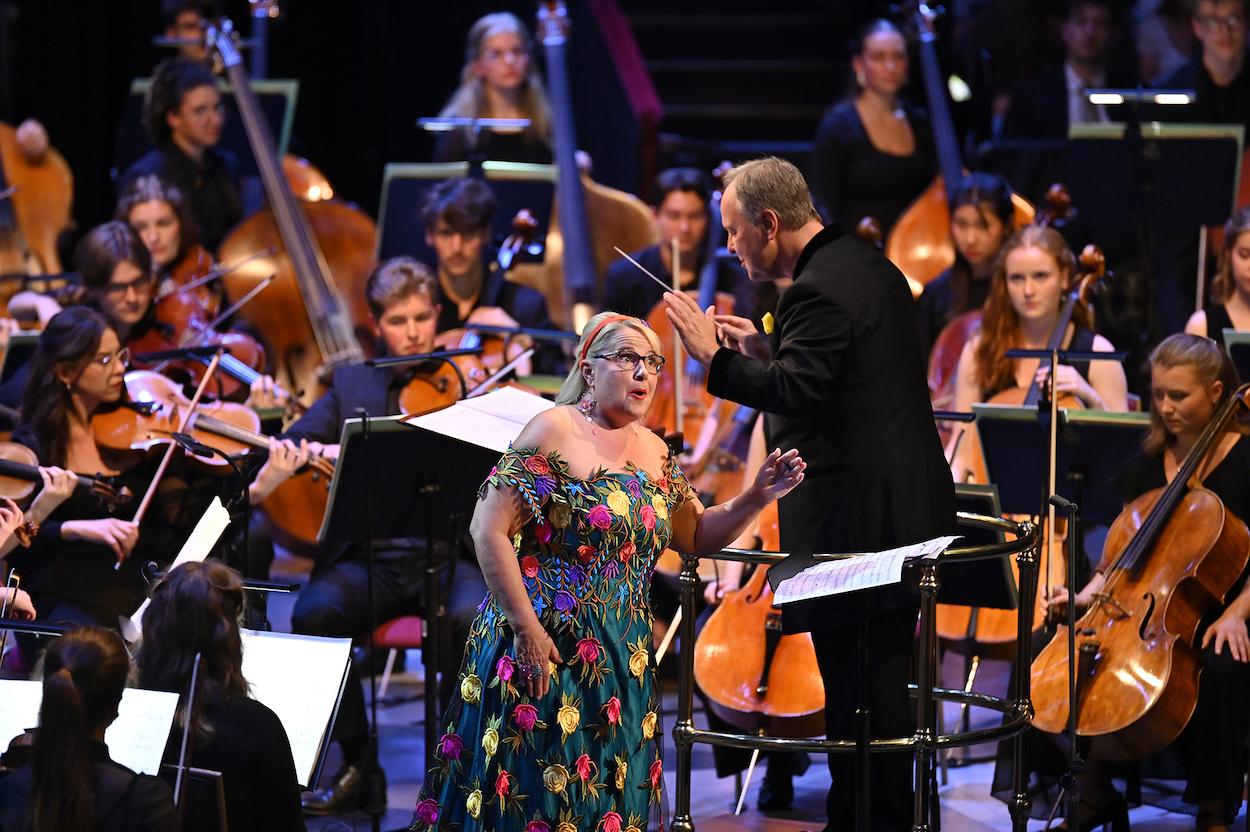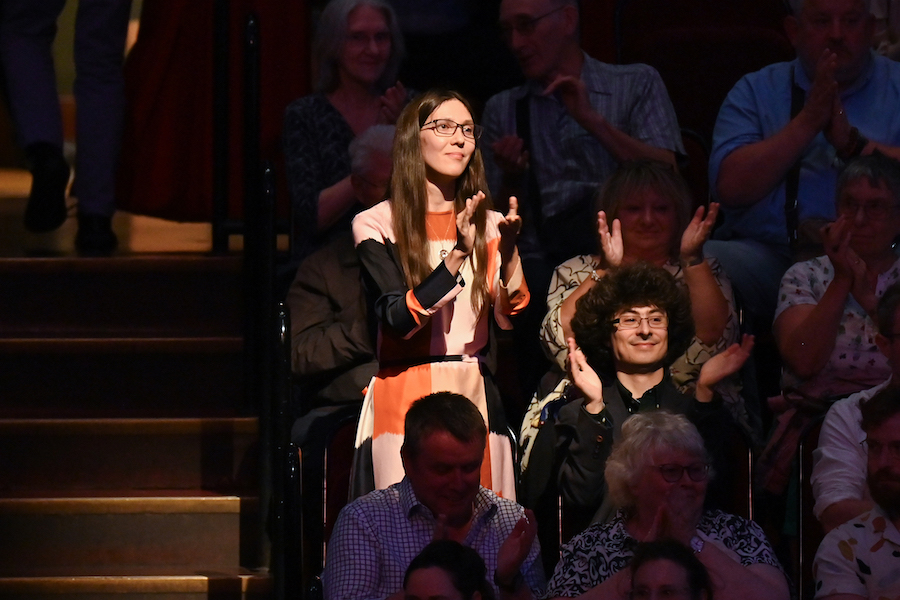For the first time the combined forces of the Royal College of Music and the Sibelius Academy (Finland) amassed on the stage of the Royal Albert Hall. To debut in front of 5000 people must be quite a daunting experience, but I detected no signs of big night nerves in this very large orchestra. It must have something to do with conductor Sakari Oramo’s calming, decisive and affable manner.
The long-overlooked tone poem The Wood Nymph (1894-95) by Jean Sibelius opened the concert. This early work blends folklore and Symbolist melodrama with hints of eroticism. It’s based on Viktor Rydberg’s Swedish poem Skogsrået (1882), which was handed out to the audience at the premiere of Sibelius’ composition. I felt I needed it during the concert. After the opening fanfare an almost minimalist sound field opens up where the listener is held in restless anticipation. This lasts for many minutes and is by far the most interesting part of this rather average tone poem (by Sibelius’s very high standards). In the third section a cello takes on the role of the seductive nymph. Her cantilena corrupts the handsome Björn, the hero of the piece, who in the end can’t resist. Björn’s heart has been stolen by a mythological maiden and no woman can match her love making. Henceforth Björn can never find a wife that lives up to his expectations and lives out his days as a grumpy ol’ codger. It’s all there in the music, apparently, if you know your Wagner harmonies. I could have done with more ¨dwarves in jet black garb¨ and less ¨sleepy water¨. But there are plenty of moments in the music when you can hear echoes of great things to come. The young musicians played their socks off, but would have been better served with Sibelius’ tone poems Tapiola or Nightride and Sunrise.

As a 15-year old I spent three weeks on a farm in the South of Finland. I learned how to milk a cow by hand, I was heartbroken when we had to bury a young calf and I was little bit smitten with the farmer’s blond haired daughter. She was six years older, so fat chance. I also had the pleasure of hearing some old-fashioned ¨kulning¨ when the farmer’s wife was rounding up the cows for milking. ¨Kulning¨ is a Scandinavian word for herding cows with a songful call. In general it’s a high-pitched singing technique that is practised by women. You can find plenty of ‘artistic’ examples of kulning on YouTube.
The Finnish soprano Anu Komsi introduced Proms audiences back in 2018 to the kulning phenomenon when she demonstrated the herding call before starting the programmed repertoire. The Finnish-American composer Lara Poe became fascinated by this ancient tradition which (judging by the posts on YouTube) has a greater fanbase in Sweden than in Finland. When Poe was commissioned by the BBC to write Laulut Maaseudulta (Songs from the Countryside) for the Proms, she composed the song cycle with Anu Komsi in mind. Five of the seven songs of the Countryside cycle have a text based on a conversation Lara Poe had with her grandmother about life on the farm in Espoo, not far from Helsinki, where she grew up in the 1930s and right through the war.
Anu Komsi treats us in the Introductory song to some exquisite singing in ‘kulning’ style floating on a musical cloud shimmering ethereally in the soft morning breeze. Next is a song describing cows that are either stubborn, big, majestic or just quite ordinary. They have typical Finnish cow names like (translated) Rosy, Strawberry, Blueberry and Raisin (yes, really!). This is followed by a rather wordy story featuring an escapee calf looking to join another herd, four adventurous brown calves and yet another obstinate cow. The tone colours change as the story evolves and Anu Komsi’s head tones towards the end of the tale reach stratospheric heights. I could have done with a little bit less storytelling and more pure song. In The Storm, which is one of two songs that are not based on Poe’s grandmother’s stories, is musically the most accomplished piece with slow tension building in woodwind and brass, with plenty of tremolo and glissando strings, spectralism and microtonal murkiness. Eventually three, four melodies and rhythms, thunder into each other. The Storm morphs into a plaintive song about two horses that, having served in the war, suffered from PTSD, which made them difficult to work with. More than 400,000 Karelians were evacuated from the border territories when the Russians invaded Finland in WWII. They were given plots of land all over the country when Stalin refused to hand back the occupied territories. Poe weaves a number of traditional Karelian folk tunes into the orchestral part. The song cycle finishes in the forest on a peaceful and fading note with Anu Komsi’s voice climbing ever higher, into the warm stratopause.

Gustav Holst’s suite The Planets needs no introduction. A number of the seven suites have been used and referenced numerous times in various British media. And what would film music in hundreds of war movies, Star Wars or in the space race drama The Right Stuff have sounded like if Holst hadn’t written Mars, the Bringer of War?
In the opening suite the combined forces of the two renowned music academies were not in a particularly bellicose mood and definitely less brutal than the pictures that we currently get from various theatres of war. Venus, the Bringer of Peace was given a romantic treatment and the violin and oboe solos delicately pulled at the heartstrings. Jupiter, the Bringer of Jollity suited this band of young musicians to a tee. The tune in the suite that, with Holst’s reluctant permission, was turned into the now popular hymn ‘I vow to thee, my country’ sounded distinctly Elgarian. Nothing wrong with that and Oramo is a great admirer of Sir Edward.
Saturn, the Bringer of Old Age, with time relentlessly ticking away on the two harps imitating a grandfather clock, contained the right amount of weariness, angst and film noir atmosphere. In the end the bells bring some relief and it’s not all doom and gloom. Uranus, the Magician, appeared to be an exhilarating and fun place to visit. A little bit like a rumbustious parade at a Disney amusement park until the organ booms: That’s enough, time to go! Neptune is the last and most ‘spacy’ suite of the lot, mysterious and quiet as I expect outer space to sound. Since Holst wrote The Planets it’s hard to imagine outer space without high-pitched voices singing wordless notes. Off stage the Royal College of Music Chamber Choir achieved an icy and distanced tone that probably perfectly encapsulates (at least in audio) Neptune , the coldest and most remote planet in our solar system. Overall this well rehearsed, energetic interpretation had a lot of inner detail, a high standard of solo work and plenty of warm colour to make The Planets really shine.
The genial looking Sakari Oramo must have been pleased with the performances he got from this large company of young and very talented musicians.
Exactly the same programme with the same musicians will be repeated in Helsinki, Finland on September 1.
You can find the details here
If you live in the UK you can find this concert on the BBC Sounds App



